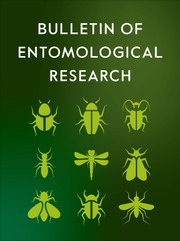No CrossRef data available.
Article contents
First report of life table of Cyamophila willeti (Hemiptera: Psyllidae) constructed using age-stage two-sex life table theory
Published online by Cambridge University Press: 21 October 2025
Abstract
The study systematically investigated the key biological and ecological characteristics of Cyamophila willeti, a major pest of the tree species Styphnolobium japonicum. We focused on its circadian mating rhythm, oviposition preference, and the effects of temperature on population parameters. Using the age-stage, two-sex life table approach, we compared the development, reproduction, and population growth potential under different temperature conditions. Results showed that mating activity peaked at 12:00 and 17:00, with females significantly preferring shoot tips for oviposition. At 25°C, female and male adult longevities were 39.88 ± 0.93 and 46.71 ± 1.69 days, respectively, and the mean fecundity per female was 647.75 ± 52.94 eggs. At 29°C, longevity was significantly reduced to 11.88 ± 4.10 days for females and 13.89 ± 4.31 days for males, while fecundity decreased to 47.63 ± 4.26 eggs. Most nymphs did not develop beyond the fifth instar at 33°C. These findings indicate that the optimal temperature for population growth of C. willeti is around 25°C, whereas high temperatures (≥29°C) significantly suppress survival and reproduction. This study establishes a foundation for monitoring C. willeti and developing effective control strategies.
Keywords
Information
- Type
- Research Paper
- Information
- Copyright
- © The Author(s), 2025. Published by Cambridge University Press.


